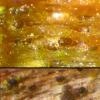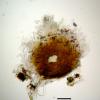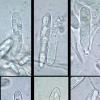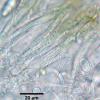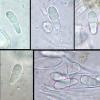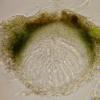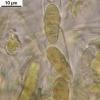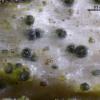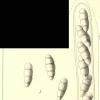
09-12-2025 12:06
 Andgelo Mombert
Andgelo Mombert
Bonjour,Je recherche l'article concernant Hypobryo

07-12-2025 16:07
Arnold BüschlenHallo, ich habe in einer Moos-Aufsammlung (epiphy

08-12-2025 21:04
Mark Stevens"Hello everyone,I'm relatively new to microscopy (

08-12-2025 18:59
 Lothar Krieglsteiner
Lothar Krieglsteiner
.. found by a seminar-participant, I do not know t

08-12-2025 17:37
 Lothar Krieglsteiner
Lothar Krieglsteiner
20.6.25, on branch of Abies infected and thickened

16-03-2014 22:00
Hello,I found this species a few months ago but ha

08-12-2025 13:39
Thomas Læssøehttps://svampe.databasen.org/observations/10572899
Leptosphaeria ??? on Quercus
Martin Bemmann,
22-07-2010 23:59
 Dear all,
Dear all,since some days I enjoy scanning a piece of oak wood I collected behind the house I'm living.
So far it featured Orbilia aprilis, Mollisia ligni and Rhamphoria pyriformis.
This evening I checked for further species and I found an even mor tiny one than the Rhamphoria (there are still more tiny ones, I'm afraid...).
The perithecia have the shape of a lentil, the lower part immersed in the substratum, brown speckled, partially hyaline. Size (on the slide with cover glass) is 350 µm in dm. of the largest specimen I found.
The ostiole (again on the slide) measured 50 µm in dm. (quite large I think).
The asci are cylindric with a short stipe and measure 54,5-74,9 x 11,8-13,8 µm.
Paraphyses are multi-septated and sometimes branched (c. 3 µm thick)
Now the spores ( those made me think on Leptosphaeria by shape): they are hyaline and clavate with 3 septa and tapered at the septa. Size is (16,4) 17,7 - 21,9 (22,3) x (5,5) 6,3 - 7,6 (7,9) µm
Any idea is very appreciated!
Best regards,
Martin
Martin Bemmann,
22-07-2010 23:59
Christian Lechat,
23-07-2010 05:08

Re:Leptosphaeria ??? on Quercus
Dear Martin,
I don't know what is your fungus but did you consider the genus Melioliphila?
I don't know what is your fungus but did you consider the genus Melioliphila?
Martin Bemmann,
23-07-2010 11:22

Re:Leptosphaeria ??? on Quercus
Dear Christian,
Thank you for your suggestion! I don't have the literature to check this genus but I have read that it is "Hyperparasitic on superficial foliicolous ascomycetes" (Pirozynski, Kew Bulletin 31 (3), 1977, p. 595).
But this guided me in the right direction, I think: I came across Tubeufia/Acanthostigmella brevispina that seems to be very close though I did not observe spines on the ascocarp and it should grow on old Hypoxylon deustum. But maybe there are other species in this genus that would match my collection.
Best regards,
Martin
Thank you for your suggestion! I don't have the literature to check this genus but I have read that it is "Hyperparasitic on superficial foliicolous ascomycetes" (Pirozynski, Kew Bulletin 31 (3), 1977, p. 595).
But this guided me in the right direction, I think: I came across Tubeufia/Acanthostigmella brevispina that seems to be very close though I did not observe spines on the ascocarp and it should grow on old Hypoxylon deustum. But maybe there are other species in this genus that would match my collection.
Best regards,
Martin
Hans-Otto Baral,
03-08-2010 17:42

Re:Leptosphaeria ??? on Quercus
I was thinking that I answered from Lapland to this contribution. This fungus seems to be Exarmidium inclusum. Apparently M. Barr identified a collection as such. Cannot tell a literature about it.
Zotto
Zotto
Martin Bemmann,
04-08-2010 09:18

Re:Leptosphaeria ??? on Quercus
I could not consult Aptroot, A world revision of Massarina, Nova Hedwigia 66(1-2): 140 (1998) since I have no access to this journal (can someone provide it?). But in Sherwood-Pike/Boise, Brittonia, 38(1), 1986, pp. 35-44, where Exarmidium inclusum is treated (as Xylopezia inclusa) I could see that it has smaller ((11.5) 13-16 (17) x 4-6 µm) and and much more fusiform spores than my collection. Other Xylopezia species shown there do also not fit well.
Regards,
Martin
Regards,
Martin
Hans-Otto Baral,
04-08-2010 11:21

Re:Leptosphaeria ??? on Quercus
Hi Martin
I see some variation in spore size among the four specimens I have seen, but I feel they belong to the same species (at least same genus).
F.ex.:
*18-21 x 7.3-7.8 µm, 3-septate, 2nd cell distinctly wider,
or *16.2-19.2 x 7-7.7-9 µm (HB 8204b)
Usually the ascomata were perithecioid but in one (HB 6226) apothecioid. 6226 and 6045 are on the DVD, under a name I forgot, perhaps Micraspis or Tarbertia.
Here images from a find from S-Sweden, on Rosa (HB 8204b)
I see some variation in spore size among the four specimens I have seen, but I feel they belong to the same species (at least same genus).
F.ex.:
*18-21 x 7.3-7.8 µm, 3-septate, 2nd cell distinctly wider,
or *16.2-19.2 x 7-7.7-9 µm (HB 8204b)
Usually the ascomata were perithecioid but in one (HB 6226) apothecioid. 6226 and 6045 are on the DVD, under a name I forgot, perhaps Micraspis or Tarbertia.
Here images from a find from S-Sweden, on Rosa (HB 8204b)
Hans-Otto Baral,
04-08-2010 11:27

Re:Leptosphaeria ??? on Quercus
Perithecia. I now remember we had this species already in the forum:
http://www.ascofrance.fr/index.php?r=forum&page=viewtopic&id=11375&highlight=exarmidium#msg11382
http://www.ascofrance.fr/index.php?r=forum&page=viewtopic&id=11375&highlight=exarmidium#msg11382
Martin Bemmann,
04-08-2010 11:36

Re:Leptosphaeria ??? on Quercus
Yes Zotto,
especially your collection 6226 fits very well to my find. Meanwhile I read Barr/Boise, A Revision of Exarmidium, Mycotaxon 23, 1985, 233-240 and stumbled upon E. diaphanum (Zignoella diaphana). The description fits very well (even by sporesize).
Below I give Berlese's illustration that shows a lentil shaped perithecium as I had observed.
Regards,
Martin
especially your collection 6226 fits very well to my find. Meanwhile I read Barr/Boise, A Revision of Exarmidium, Mycotaxon 23, 1985, 233-240 and stumbled upon E. diaphanum (Zignoella diaphana). The description fits very well (even by sporesize).
Below I give Berlese's illustration that shows a lentil shaped perithecium as I had observed.
Regards,
Martin

